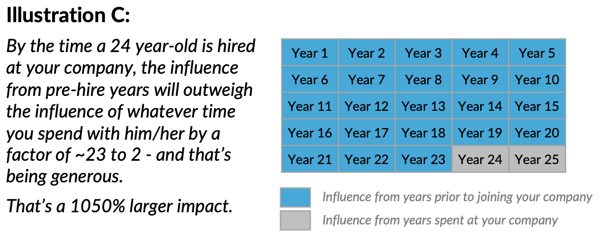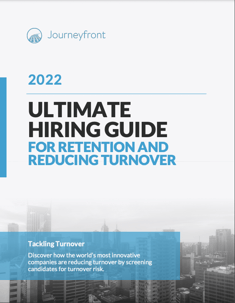Jim Collins said, “The most important decisions business people make are not what decisions, but who decisions.” If 80% of your turnover is the result of bad hiring decisions, the most important thing you can do to decrease employee turnover is to focus on hiring people more likely to stay.
Companies make bad hiring decisions for a variety of reasons, including:
- An inability to measure the attributes and characteristics that matter most
- Difficulty incorporating the best methods to identify the desired attributes
- Making hasty decisions due to lack of time
"Employers spend an average of 6 seconds reviewing an individual resume." -TheLadders
It’s safe to assume this isn’t due to a lack of effort, but a lack of resources to identify what matters most in hiring in a strategic period of time. To truly get to the bottom of reducing turnover, the best place to start would be to identify the most important drivers of turnover to address in the hiring decision.
This assertion is supported by a simple, commonsense proposition: Employees bring a lifetime of training, experience, and personal characteristics that bear on their capacity to be successful and their chances of being satisfied in a position. Measuring the right employee attributes that develop over a lifetime; determining their capacity to predict employee satisfaction, performance, and turnover; and utilizing these characteristics in employee selection offers a powerful opportunity to select employees who will be more satisfied and successful.
Employee Experience Before Your Company
To be clear, this isn’t to say that people aren’t influenced by their work environments. Indeed, they are. However, the training and experiences an employee has had before coming to your company will vastly outweigh whatever experiences they have during the comparatively limited time they spend at your company.

Any efforts a company may take post-hire to influence an employee will pale in comparison to the influence of their past life experiences, as well as their own personal traits.
The application of this strategy may also reduce, if not eliminate, the need for costly and time-consuming programs to enhance employee performance and satisfaction if, in fact, the drivers of these programs are rooted in hiring practices that are yielding poorly suited employees.
Given this fact, it’s surprising that only the most innovative companies have grasped the power of screening for turnover risk. Far too many companies focus solely on screening for the traditional factors (performance-related criteria, culture, etc.) when, in reality, screening for turnover is the answer they have been waiting for.
How to Calculate Turnover Costs
For many businesses, the determination of whether to implement changes often comes down to the proverbial bottom line. Does the financial impact justify the necessary cost, time, and effort to make the required changes? We can help you make that decision.
Calculating your company’s turnover rate for any given period of time is a matter of comparing the number of employees who have left for any reason, whether voluntarily or involuntarily, with the average number of employees during that same period. To ascertain the turnover rate for a month, begin by counting the employees who have left the company during that month.
Next, determine the average number of employees working at the business during the month. One simple manner of accomplishing this is to take the employee count on the first date of the month, add the employee count on the last day of the month, and divide the total by 2. This gives us our average.
Divide the number of employees who left by the average number of employees. Take the answer and multiply it by 100. That gives you your turnover percentage. The formula looks like this:
Turnover Rate = (Employees Who Left That Month / Average Employee Count) x 100
If 14 employees left and you have an average of 105 employees for the month, it would look like this:
13.33% = (14 / 105) x 100
Before you begin calculating your turnover rate, it’s prudent to research the average turnover rate in your industry. While it won’t help calculate your rate, it will put your findings in perspective. For example, if the industry rate is 5-10%, and your company’s rate is 8%, this means you have an average turnover rate.
In order to determine how much your turnover rate is costing you, download our turnover calculator. You may be surprised by the potential savings.
Effects of High Turnover
It should be stated that not all turnover is bad for your business. In fact, a small amount of turnover can be a good thing. When employees retire, this creates an opportunity for you to bring in fresh talent.
It is also worth noting that every organization has employees who either don’t add value to your company or are not a good fit for their position and/or your work culture. When these types of employees leave, it can yield positive benefits.
However, when turnover gets too high, it becomes a serious issue that needs to be addressed, especially when it involves high-value employees leaving your company. Having a high turnover rate can affect your business in several ways.
Revenue Loss
Losing employees that develop working relationships with your clients can result in a potential loss of said clients. When clients have a working relationship with a specific employee, it creates an incentive to follow that employee elsewhere. It can also damage the experience your clients have with your company, especially if you don’t have anyone who can pick up that employee’s responsibilities. Either way, high turnover can directly impact your revenue and even help your competition.
Decrease in Production
When an employee leaves your company, that can create a drop in production, especially if that employee was a long-time veteran. Sometimes this is unavoidable, such as when someone retires, but if large numbers of experienced employees are leaving, this will create a massive problem.
When an experienced employee departs, someone will have to fill in and take over their responsibilities. This will often fall to other employees who will be pulled away from their own workload. This not only has the potential to result in the expenditure of additional resources but also more overworked employees as it may take weeks to hire a new employee and get them trained and integrated into the position.
Recruiting Difficulties
Once it becomes known that your company has a high turnover rate, you may find your HR department will have difficulty finding high-value employees. Fewer people will want to join your company if your business is viewed as a revolving door. In addition, losing talent to your competition can cause you to lose your competitive edge.
Decreased Morale
When your company is experiencing high turnover rates, this can directly impact the morale of your remaining employees. As mentioned above, high turnover can result in your employees feeling overworked, as they are experiencing higher levels of stress. In addition, a high turnover rate can result in your employees losing trust in management which will further decrease morale at your company.
Reasons Turnover Occurs
Every company will experience employee turnover, and it will occur for a variety of reasons. Some reasons, such as an employee leaving after reaching retirement age, you won’t have to worry about as there isn’t much you can do. However, there are plenty of reasons that you do have the ability to influence, and we’ll focus on some of the more common ones.
Overwork
As the needs of production wax or wan, you may have to temporarily add to the workload of your employees, but take care: If you overburden your staff too often, this can lead to overwhelming levels of stress and burnout. Employees who are burned out will not only be less productive but will also likely be looking for other jobs.
Lack of Feedback
Feedback is crucial to empowering employees to excel at their work. If you are neglecting giving them the feedback they need, it can cause your employees to become discouraged and begin struggling. When you give honest feedback, it can help your employees refocus and progress.
Poor Employee Selection
Hiring the right kind of employee is never easy, but this is an essential strategy for reducing employee turnover in your company. It’s crucial to identify and hire employees who are coachable, a good fit for the company culture, capable of excelling in the position, and who are not likely to leave prematurely.
How to Improve Employee Turnover
When it comes employee turnover in your company, there are several efficient strategies to reduce employee turnover that you can implement.
Be Transparent
Being transparent with your employees is a great strategy for not only retaining your employees but also building a better workplace environment. Being open and honest can develop bonds that are difficult to break. You don’t need to divulge every secret of your company, but you shouldn’t be hesitant to share what you can. Having an open dialogue where you can give and receive honest feedback will yield positive results.
Having an open-door policy can also be beneficial, as it allows employees to receive guidance and build trust.
Be Competitive
Offering competitive benefits and compensation can go a long way. Employees like to be well-compensated for their work, and if they feel they aren’t being appropriately valued at your company, they’ll look for a competitor who will meet their requirements. Be sure to research the industry and your competition in order to determine what competitive pay and benefits should look like.
Be Accommodating
When you hire new employees, it’s imperative that you provide a great onboarding experience. You shouldn’t abandon new hires to fend for themselves. Instead, take the time to show them around your company, ensure that they are set up with payroll, and see to it that they are receiving their benefits.
According to Gallup, only 12% of employees strongly feel that their company provides a great onboarding experience. This means that if you take the necessary steps to help your employees get settled in, your company can set itself apart from the competition as one that takes care of those they hire.
Be Appreciative
You can also show appreciation to your staff in order to increase morale and decrease turnover. Recognizing and rewarding your employees for a job well done may seem like a small thing, but it can create a big impact.
Consider creating a periodic email newsletter that highlights the achievements of employees or simply giving a thank you letter and/or small gift to an employee for their stellar performance. There are various avenues of showing appreciation, so feel free to be inventive.
Be Flexible
Another strategy to decrease employee turnover is to offer flexible scheduling. This can take many forms, such as telecommuting, 4-day work weeks, job sharing, and more. Offering an on-site daycare can also be a good investment.
According to a University of Michigan study, working arrangements that allow workers more freedom with their time can ultimately result in better sleep quality, higher energy levels, and overall better health. To decrease turnover, consider what your employees need in order to determine how to best offer flexibility to them.
Show a Way Forward
Every employee wants to know that advancement in their career is possible. They want to be sure that hard work and learning new skills can result in achieving higher positions and better compensation.
The best way to address this concern is to be open and crystal clear about career paths for your employees. You should show them the steps they should take and where those steps will eventually lead. In order to determine the steps any given employee should take, you can use annual and/or quarterly reviews to learn about their experience and skill set.
Be Proactive
However, the best way to improve your employee turnover rate occurs before your employees even begin working at your company.
We mentioned above that the biggest factor in turnover rates comes from poor hiring decisions. By ensuring that your recruits are high quality, you’ll be able to enjoy the value that they bring to your company while avoiding the potential problems that hiring a low quality employee can bring.
Therefore, screening your employees based on job qualifications, whether they’ll be a good fit for your company, and whether they are likely to remain in that spot for long will all have a major positive impact on your employee turnover rate.
Use the Power of Analytics
If you are interested in learning how to effectively screen employees to decrease your employee turnover rate, contact us today. We can help you use the power of predictive analytics to help you find employees that are not only qualified for the positions but also will make a great fit for your company and are less likely to turn over.
Be sure to also follow our blog for more strategies and tips about the hiring process.
Enjoy this article? This is a small portion of our hiring guide "The Ultimate Hiring Guide for Reducing Turnover." Take a look!
Click here to download the complete guide






